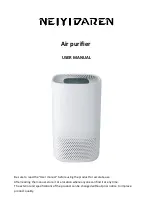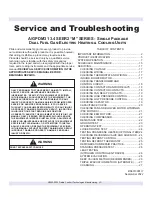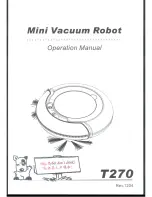
99
E
n
g
l
i
s
h
6. Can I place Airfree
®
at the corridor to reach adjacent rooms?
No. Airfree
®
will just reduce air pollution in the corridor’s area.
7. Can I place Airfree
®
in a closed room?
Yes. Please remember such a room must have at least 10 m
3
.
8. Can I change Airfree
®
from one room to another?
Airfree
®
must always be plugged in the same room 24 hours a day. Airfree
’
s patented technology works
gradually and cannot have its cycle interrupted. Moving it from one room to another will interrupt the cycle
and the room will start being contaminated again.
9. Should I turn off Airfree
®
when I leave house?
No. Airfree
®
must always be ON.
10. What happens if Airfree
®
is disconnected or there was a black out?
Airfree
®
will take approximately the same time to recover the previous reduced contamination level.
11. Does CADR measure the effectiveness of the Airfree
®
?
Not at all. CADR is not designed to test the Airfree
®
technology. The AHAM seal (usually found on the back
of an air cleaner’s box) lists three Clean Air Delivery Rate (CADR) numbers: one for tobacco smoke, one for
pollen and one for dust. The CADR indicates volume of filtered air delivered by an air cleaner. The reason
why CADR is not designed for Airfree
®
is because Airfree
®
does not filter but destroys microorganisms
instead, such reduction of bacteria, moulds, viruses and other microorganisms can only be measured after
air sample incubation in a microbiology lab. Airfree
®
destroys (not trap or attract to other surface) any mi-
croorganism regardless of how small they might be. 99.99% of all microorganisms are fully destroyed when
passing through the Airfree
®
patented ceramic core.
12. Does Airfree
®
eliminate bacteria and viruses?
Yes. Unlike the air filters in the market
Airfree
®
is more efficient with the smallest microorganisms as they
are easily carried by Airfree
’
s airflow into the sterilising TSS
™ ceramic core. Please check the independent
bacteria and virus tests at our website.
13. How does Airfree
®
destroy dust mites?
Mould reduction in the environment causes reduction in the mould dependant dust mite population. Airfree
®
also destroys the harmful toxins and fungus freed into the air by dust mite feces and skeletons that trigger
respiratory allergies and asthma.
14. How does Airfree
®
eliminate fungi and moulds?
As mentioned before, Airfree
®
eliminates airborne microorganisms there included moulds, fungi and spores.
By eliminating spores new mould colonies are unlikely to develop, representing less future airborne mould
spores. Please check the independent mould tests at our website.
15. Does Airfree
®
reduce tobacco smell?
Yes, Airfree
®
reduces any kind of organic smell in the ambience including tobacco.
16. How does Airfree
®
destroy viruses?
Those microscopic microorganisms are easily eliminated inside Airfree
’
s ceramic core capillaries. Contrary
to other technologies the smallest the microorganisms the easiest they are destroyed inside the TSS™
ceramic core capillaries. Please check the independent virus test at our website.
17. Does Airfree
®
make any humidity level change in the room?
No.
18. Does Airfree
®
release any gas or chemical product?
No. Airfree
’
s sterilisation process is natural. Please check our website for conclusive tests regarding parti-
cles and ozone.
19. Does Airfree
®
heat up a room?
No. Airfree
®
does not make any noticeable increase in the room temperature. Just for comparison two
Airfree
®
devices plugged in the same room will contribute as much heat as one 70 kg adult.










































